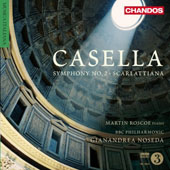
ESSENTIAL RECORDINGS

Unlike many composers, who like movie directors, leave all the action for the last few minutes near the end, Alfredo Casella (1883-1947) does not
waste any time and hits the ground running. Within 45 seconds into the first movement of his Symphony No. 2, Op. 12 of which this is a premiere
recording, you know that you are in for a thrill ride. Like his compatriot of the same generation, Ottorino Respighi, this Italian composer turned his back on the prevailing
fashion of writing operas, to concentrate on instrumental, chamber and orchestral works. As a teenager, he studied at the Paris Conservatoire where he received the level
of musical education necessary for his ambitions. A by-product of his stay in Paris was his affinity with the Russian style, which might explain why the second movement
of this symphony brings to mind Rimsky-Korsakov when I hear it. His real passion was for the music of Gustav Mahler. Upon their meeting in 1909, Casella informed
Mahler that he knew all his symphonies 'by heart'.
The symphony opens with an ominous and foreboding build-up complete with the tolling of dark bells that quickly builds and maintains a constant momentum and high
level of activity. Unlike Mahler who was patient and could let something simmer for an hour before bringing it to a boil, Casella's nervous energy and constant tempo
shifts mean there is always something cooking. This movement goes through many hurdles before coming to an impressive end. The second movement, which takes on
the role of Scherzo in this work is, like I've mentioned before, rather Scheherazadian in style and sound. It contains sparkling brass segments combined with
exotic percussion and rapid-fire rhythms. Even in the slow Adagio there is still a rather high level of activity, which prevents this movement from sagging
into an overly gloomy affair, and builds to an over-the-top climax marked 'appassionatissimo' that demands full force from the orchestra. The fourth movement
is a typical angst filled military sounding march in a minor mode, with pounding percussion and heavy brass. All of which is extremely well orchestrated. The fifth and
final movement, in my opinion, is Casella's tip of the hat to Mahler, and in particular to Mahler's own Second Symphony. Just like an uplifting Mahler moment, it recalls
important themes from the rest of the work, and slowly and confidently builds to an emotionally powerful climax complete with lots of clanging bells, pipe organ, and
every member of the orchestra playing as loud as they possibly can. The only thing missing is a massive choir.
This is a brilliant and splendid symphonic work which again begs the question; why has great music like this been ignored for so long? Labels like Chandos
in this case, have lately been rectifying the situation by seeking out works like this one, and re-creating them in the recording studio or concert hall, for all of us to enjoy.
And if this newly presented symphony wasn't enough, the CD also contains a first rate performance of Scarlattiana, Op. 44, which is a 'Divertimento
on music by Domenico Scarlatti for piano and small orchestra'. A delightful neo-classical work based on many different segments of various Scarlatti sonatas, played on
the piano, with constant interactions with the orchestra.
This is a premiere recording of this symphony. Don't miss it. Alfredo Casella is a master orchestrator and composer, deserving of much more attention than he's received
up until now. This truly impressive recording by Chandos, with Gianandrea Noseda conducting the BBC Philharmonic should turn
the tables around and cause quite a stir in the music world.
Jean-Yves Duperron